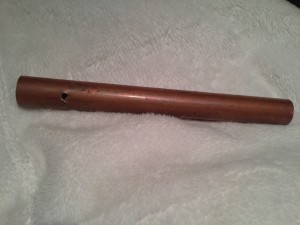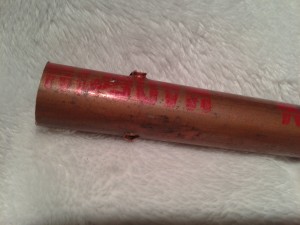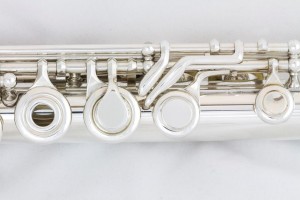I am not Lev Levit
I do not, as a rule, make flutes. No one has ever introduced me at a dinner party as, “I’d like you to meet the Big Ugly Man Doll – he makes flutes.” Doesn’t happen. I can’t even whistle in key. This is in stark contrast to my friend Lev, who does, in fact, make flutes. Damn good ones.
One of the most distinguishing of the differences between us, which are many, starting with his flutemaking company, is this: deliberation. Lev sits down to make a flute in a very deliberate and careful fashion. He’s not an impulsive or “spur of the moment” or “well, that should fit” kind of guy when he’s making a flute. Honestly, I expect he’s probably the same way when he’s doing something else, such as, oh, I don’t know, hanging a cabinet.
Speaking of hanging cabinets, though, while it is also true that no one has ever introduced me at a dinner party as, “I’d like you to meet the Big Ugly Man Doll – he hangs cabinets,” I am more likely to find myself performing that activity than many others, such as, picking two at random, deep-frying whelks or making flutes. In particular, I found myself just yesterday standing on a step stool, drill in one hand and cabinet in the other, exhorting and extolling Number One Son to continue holding said cabinet up while I screwed it to the wall. Needless to say, there had been very deliberate and careful preparation beforehand; I do not hang cabinets in an impulsive or “spur of the moment” way. You know, mostly.
Having done this before, I knew to mark off the bottom of the cabinets and screw in a “set” bar, on which I could rest the cabinets while screwing them to the wall. This is important when hanging reasonably heavy cabinets, and even more so when your primary assistant is a highly ADHD 12-year-old who can’t bench press anything heavier than a Nintento. I also knew to mark – below where the set bar was, so you can see it – a notation about where the studs are. To do this, I used a studfinder. If you’re not familiar with this tool, it’s a small device that you hold up to your wall and drag slowly across until it screeches at you that there’s something interesting behind it. Since safety is our middle name, it will also screech at you if that something interesting happens to be a live electrical current.
So there I was, set bar in place, studs marked, with two cabinets hung on the wall and screwed to one another, when I realized four things in rapid succession:
- The cabinet door was scraping the ceiling a little.
- The action of knocking said door down a little had just pulled both cabinets out of the wall.
- They were about to fall on my head.
- My highly ADHD assistant was nowhere to be found.
Thinking quickly, I held them up with one hand while groping for more screws with the other, and screwed one of the cabinets more fully into the wall. I then unscrewed the other and took it down, for further work on the doors. That’s when I really stepped in it.
Well, that’s not true. That’s when I stepped in the puddle of water on the floor. We had had some slight leakage the day before from the washing machine, and I panicked for a moment thinking it was still leaking – very much a problem, since it wasn’t running. I took a paper towel and puddled up the water, and realized it was continuing to puddle out from the wall – the very wall to which I had just attached the first cabinet. The very wall with the valve to the outside water supply on it.
It was at this point that I was graced with the presence of more help, in the royal person of the Reigning Queen of Pink. I showed her the water, and mentioned that I really hoped I hadn’t just put a screw through a water pipe behind the wall.
“I really hope you have, Daddy!” says she.
“Why’s that?” I asked.
“Because if you didn’t, then what the hell’s leaking?” says she.
You know, that’s a smart kid. Without further ado, I removed the first cabinet from the wall and took the keyhole saw to the wall, around the general location of the screw-holes I’d left. Pulling away the drywall – dry no longer! – we saw the nice little hole I’d put right through the center of the pipe, and the nice little quiet stream of water as it made its wet little way to the floor. So, when I’d really stepped in it was when I decided that my first screw (which had merely grazed the pipe) didn’t feel like it had sunk into the stud properly, and I’d placed a new screw just a little higher and to the right. That one felt like it really grabbed something. Oh, yes it had.
Definition: Studfinder (noun), little beeping piece of shit very useful for finding water pipes behind drywall.
I do not, as a rule, make flutes. This is why. It was exactly as I was taking some plumbers tape to wrap around the hole, just to make it stop flowing water to the ground, that the phone rang.
The RQoP picked it up, on seeing that it was her mother SOBUMD, and by way of hello shouted, “Guess what? Daddy really screwed up!” Then, to me, “Can I tell her?”
Thanks, kid. I think you just have.
SOBUMD had the presence of mind to get me to call neighbor Mike, instead of a plumber, since neighbor Mike can fix anything and usually accepts beer and thanks as currency. Sure enough, Mike walked over with a sawzall, a blowtorch, and some plumbing stuff, and in a few moments we had a new pipe in the wall – and a new flute in the making.
Here’s a close up of the through-and-through of my perfidious hole. I’d grazed the pipe with the two screws in my set bar, and again with the first cabinet screw that I didn’t think had really hit the stud well enough. For the sake of contrast, here’s what my friend Lev Levit’s flutes look like.
So, lessons to be learned from this tale: First, you can’t trust your studfinder. Just cut a hole in the wall and look. Second, a good flute will be made deliberately, not by accident. If you’re in the market for a flute, ask the flutemaker if what they intended to make was, in fact, a flute. If you find that you’re buying a flute from a guy who was trying to build a violin, or hang a cabinet, or install Windows 8 Pro, and he just happened to end up making a flute, you should probably call my friend Lev.
He makes flutes on purpose.



Yikes. I feel your pain with the studfinder. I don’t trust the little bastards, either. I just cut out a big chunk of drywall, add extra blocking between the studs wherever I need it, and then repair the drywall and install my (fill in the blank). The advantage to this method is that I get to cut through all sorts of interesting stuff with my drywall saw…
@Diane – Yes, exactly! I’m looking forward to screwing through a power line or two as I mount the next set!
you gotta love the RQOP! Her commentary is always insightful and her discretion absolute!
Yeah, I don’t think that Lev will be hiring you anytime soon. I think that you need to drill a couple more holes and see if it plays.
Please hold onto your specimen of a flute for when I come to DC. We can compare our methods, materials and products. Or we can just have a beer!!!
Allison, it plays, but very poorly. Not unlike how I would play a more proper flute. And Lev, beer is a great idea – beer I can make deliberately! ;-)